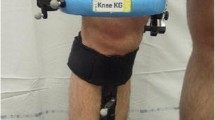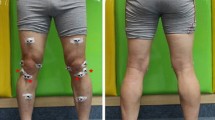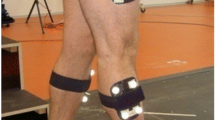Abstract
Purpose
Static, one-dimensional testing cannot predict the behaviour of the anterior cruciate ligament (ACL)-deficient knee under realistic loading conditions. Currently, the most widely accepted method for assessing joint movement patterns is gait analysis. The purpose of the study was in vivo evaluation of the behaviour of the anterior cruciate ligament-deficient (ACLD) knees during walking, using 3D, real-time assessment tool.
Methods
Biomechanical data were collected prospectively on 30 patients with ACL rupture and 15 healthy subjects as a control group, with KneeKg™ System. Kinematic data were recorded in vivo during treadmill walking at self-selected speed. Flexion/extension, abduction/adduction, anterior/posterior tibial translation and external/internal tibial rotation were compared between groups.
Results
The ACLD patients showed a significant lower extension of the knee joint during stance phase (p < 0.05; 13.2° ± 2.1° and 7.3° ± 2.7°, for ACLD and control group, respectively). A significant difference in tibial rotation angle was found in ACLD knees compared to control knees (p < 0.05). The patients with ACLD rotated the tibia more internally (−1.4° ± 0.2°) during the mid-stance phase, than control group (0.2° ± 0.3°). There was no significant difference in anteroposterior translation and adduction–abduction angles.
Conclusion
Significant alterations of joint kinematics in the ACLD knee were revealed in this study by manifesting a higher flexion gait strategy and excessive internal tibial rotation during walking that could result in a more rapid cartilage thinning throughout the knee. The preoperative data obtained in this study will be useful to understand the post-ACL reconstruction kinematic behaviour of the knee.
Clinical relevance
The findings in this study indicate that ACLD knee may adapt functionally to prevent excessive anterior–posterior translation but they fail to avoid rotational instability.

Similar content being viewed by others
References
Andriacchi TP, Briant PL, Bevill SL, Koo S (2006) Rotational changes at the knee after ACL injury cause cartilage thinning. Clin Orthop Relat Res 442:39–44
Andriacchi TP, Dyrby CO (2005) Interactions between kinematics and loading during walking for the normal and ACL deficient knee. J Biomech 38(2):293–298
Andriacchi TP, Koo S, Scanlan SF (2009) Gait mechanics influence healthy cartilage morphology and osteoarthritis of the knee. J Bone Joint Surg Am 91(Suppl 1):95–101
Andriacchi TP, Mundermann A (2006) The role of ambulatory mechanics in the initiation and progression of knee osteoarthritis. Curr Opin Rheumatol 18(5):514–518
Bendjaballah MZ, Shirazi-Adl A, Zukor DJ (1998) Biomechanical response of the passive human knee joint under anterior–posterior forces. Clin Biomech 13:625–633
Benoit DL, Ramsey DK, Lamontagne M, Xu L, Wretenberg P, Renstrom P (2006) Effect of skin movement artifact on knee kinematics during gait and cutting motions measured in vivo. Gait Posture 24(2):152–164
Berchuck M, Andriacchi TP, Bach BR, Reider B (1990) Gait adaptations by patients who have a deficient anterior cruciate ligament. J Bone Joint Surg Am 72(6):871–877
Boeth H, Duda G, Heller M et al (2013) Anterior cruciate ligament-deficient patients with passive knee joint laxity have a decreased range of anterior-posterior motion during active movements. Am J Sports Med 41:1051–1057
Branch T, Browne J, Campbell J et al (2010) Rotational laxity greater in patients with contralateral anterior cruciate ligament injury than healthy volunteers. Knee Surg Sports Traumatol Arthrosc 18(10):1379–1384
Cappozzo A, Catani F, Leardini A et al (1996) Position and orientation in space of bones during movement: experimental artefacts. Clin Bi + omech 11:90–100
Ciccoti MG, Kerlan RK, Perry J et al (1994) An electromyographic analysis of the knee during functional activities. II. The anterior cruciate ligament-deficient and reconstructed profiles. Am J Sports Med 22:651–658
Colby SM, Kirkendall DT, Bruzga RF (1999) Electromyographic analysis and energy expenditure of harness supported treadmill walking: implications for knee rehabilitation. Gait Posture 10(3):200–205
Douglas AD, Mohamed RM, Richard DK, William H (2005) In vivo determination of normal and anterior cruciate ligament-deficient knee kinematics. J Biomech 38:241–253
Frank CB, Beveridge JE, Huebner KD et al (2012) Complete ACL/MCL deficiency induces variable degrees of instability in sheep with specific kinematic abnormalities correlating with degrees of early osteoarthritis. J Orthop Res 30(3):384–392
Fuentes A, Hagemeister N, Ranger P, Heron T, Guise JA (2011) Gait adaptation in chronic anterior cruciate ligament-deficient patients: pivot-shift avoidance gait. Clin Biomech (Bristol Avon) 26(2):181–187
Gao B, Zheng NN (2010) Alterations in three-dimensional joint kinematics of anterior cruciate ligament-deficient and -reconstructed knees during walking. Clin Biomech (Bristol Avon) 25(3):222–229
Georgoulis AD, Papadonikolakis A, Papageorgiou CD, Mitsou A, Stergiou N (2003) Three-dimensional tibiofemoral kinematics of the anterior cruciate ligament deficient and reconstructed knee during walking. Am J Sports Med 31(1):75–79
Gokeler A, Schmalz T, Knopf E, Freiwald J, Blumentritt S (2003) The relationship between isokinetic quadriceps strength and laxity on gait analysis parameters in anterior cruciate ligament reconstructed knees. Knee Surg Sports Traumatol Arthrosc 11:372–378
Hagemeister N, Parent G, Van de Putte M, St-Onge N, Duval N, de Guise J (2005) A reproducible method for studying three-dimensional knee kinematics. J Biomech 38:1926–1931
Hurd WI, Snyder-Mackler L (2007) Knee instability after acute ACL rupture affects movement patterns during the mid-stance phase of gait. J Orthop Res 25:1369–1377
Espregueira-Mendes J, Pereira H, Sevivas N, Passos C, Vasconcelos JC, Monteiro A, Oliveira JM, Reis RL (2012) Assessment of rotatory laxity in anterior cruciate ligament-deficient knees using magnetic resonance imaging with porto-knee testing device. Knee Surg Sports Traumatol Arthrosc 20:671–678
Kalund S, Sinkjvr T, Arendt-Nielsen L, Simonsen O (1990) Altered timing of hamstring muscle action in anterior cruciate ligament deficient patients. Am J Sports Med 18:245–248
Kawahara K, Sekimoto T, Watanabe S et al (2012) Effect of genu recurvatum on the anterior cruciate ligament-deficient knee during gait. Knee Surg Sports Traumatol Arthrosc 20(8):1479–1487
Kizuki S, Shirakura K, Kimura M et al (1995) Dynamic analysis of anterior tibial translation during isokinetic quadriceps femoris muscle concentric contraction exercise. Knee 2:151–155
Koo S, Rylander JH, Andriacchi TP (2011) Knee joint kinematics during walking influences the spatial cartilage thickness distribution in the knee. J Biomech 44(7):1405–1409
Kvist J, Gillquist J (2001) Sagittal plane knee translation and electromyographic activity during closed and open kinetic chain exercises in anterior cruciate ligament-deficient patients and control subjects. Am J Sports Med 29:72–82
Labbe DR, Hagemeister N, Tremblay M, de Guise J (2008) Reliability of a method for analyzing three-dimensional knee kinematics during gait. Gait Posture 28:170–174
Li G, Zayontz S, DeFrate LE, Most E, Suggs JF, Rubash HE (2004) Kinematics of the knee at high flexion angles: an in vitro investigation. J Orthop Res 22:90–95
Limbird TJ, Shiavi R, Frazer M et al (1988) EMG profiles of knee joint musculature during walking: changes induced by anterior cruciate ligament deficiency. J Orthop Res 6:630–638
Li-Qun Zh, Richard GSh, Thomas JL, Jay MM (2003) Six degrees-of-freedom kinematics of ACL deficient knees during locomotion-compensatory mechanism. Gait Posture 17:34–42
Lorbach O, Wilmes P, Theisen D, Brockmeyer M, Maas S, Kohn D, Seil R (2009) Reliability testing of a new device to measure tibial rotation. Knee Surg Sports Traumatol Arthrosc 17(8):920–926
Lysholm M, Messner K (1995) Sagittal plane translation of the tibia in anterior cruciate ligamentdeficient knees during commonly used rehabilitation exercises. Scand J Med Sci Sports 5:49–56
Markolf KI, Bargar WI, Shoemaker CS, Amstutz HC (1981) The role of joint load in knee stability. J Bone Jt Surg Am 63:570–585
Moglo KE, Shirazi-Adl A (2003) Biomechanics of passive knee joint in drawer: load transmission in intact and ACL-deficient joints. Knee 10(3):265–276
Musahl V, Bell KM, Tsai AG, Costic RS, Allaire R, Zantop T, Irrgang JJ, Fu FH (2007) Development of a simple device for measurement of rotational knee laxity. Knee Surg Sports Traumatol Arthrosc 15(8):1009–1012
Patel RR, Hurwitz DE, Bush-Joseph CA, Bach BR Jr, Andriacchi TP (2003) Comparison of clinical and dynamic knee function in patients with anterior cruciate ligament deficiency. Am J Sports Med 31:68–74
Samukawa M, Magee D, Katayose M (2007) The effect of tibial rotation on the presence of instability in the anterior cruciate ligament deficient knee. J Sport Rehabil 16(1):2–17
Sati M, de Guise JA, Larouche S, Drouin G (1996) Improving in vivo knee kinematic measurements: application to prosthetic ligament analysis. Knee 3:179–190
Sati M, de Guise JA, Drouin G (1997) Computer assisted knee surgery: diagnostics and planning of knee surgery. Comput Aided Surg 2:108–123
Schmitz RJ, Ficklin TK, Shimokochi Y, Nguyen AD, Beynnon BD, Perrin DH, Shultz SJ (2008) Varus/valgus and internal/external torsional knee joint stiffness differs between sexes. Am J Sports Med 36(7):1380–1388
Sebastien L, Magnussen R, Cheze L, Neyret P (2012) The Knee KG system: a review of the literature. Knee Surg Sports Traumatol Arthrosc 20:633–638
Seon JK, Song EK, Park SJ (2006) Osteoarthritis after anterior cruciate ligament reconstruction using a patellar tendon autograft. Int Orthop 30:94–98
Solomonow M et al (1987) The synergistic action of the anterior cruciate ligament and thigh muscles in maintaining joint stability. Am J Sports Med 15:207–213
Stagni R, Fantozzi S, Cappello A, Leardini A (2005) Quantification of soft tissue artefact in motion analysis by combining 3D fluoroscopy and stereophotogrammetry: a study on two subjects. Clin Biomech (Bristol Avon) 20(3):320–329
Taylor K, Cutcliffe H, Queen R et al (2013) In vivo measurement of ACL length and relative strain during walking. J Biomech 46(3):478–483
Torzilli PA, Deng X, Warren RF (1994) The effect of joint compressive load and quadriceps muscle force on knee motion in the intact and anterior cruciate ligament sectioned knee. Am J Sports Med 22:105–112
Wexler G, Hurwitz DE, Bush-Joseph CA, Andriacchi TP, Bach BR Jr (1998) Functional gait adaptations in ACL deficient patients over time. Clin Orthop Relat Res 348:166–175
Wu JL, Hosseini A, Kozanek M, Gadikota RH, Gill JTH, Li G (2010) Kinematics of the anterior cruciate ligament during gait. Am J Sports Med 38:1475–1482
Author information
Authors and Affiliations
Corresponding author
Rights and permissions
About this article
Cite this article
Shabani, B., Bytyqi, D., Lustig, S. et al. Gait changes of the ACL-deficient knee 3D kinematic assessment. Knee Surg Sports Traumatol Arthrosc 23, 3259–3265 (2015). https://doi.org/10.1007/s00167-014-3169-0
Received:
Accepted:
Published:
Issue Date:
DOI: https://doi.org/10.1007/s00167-014-3169-0




